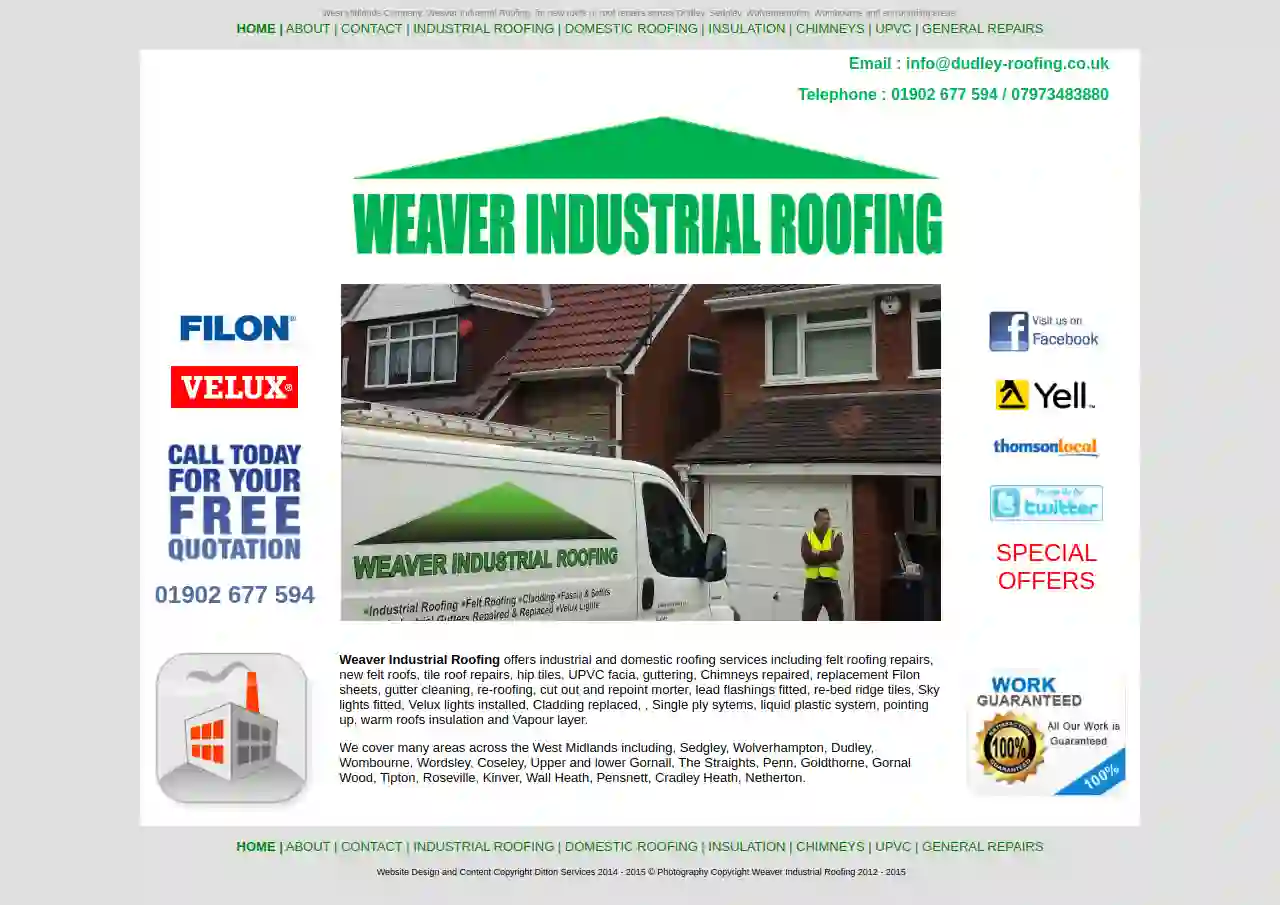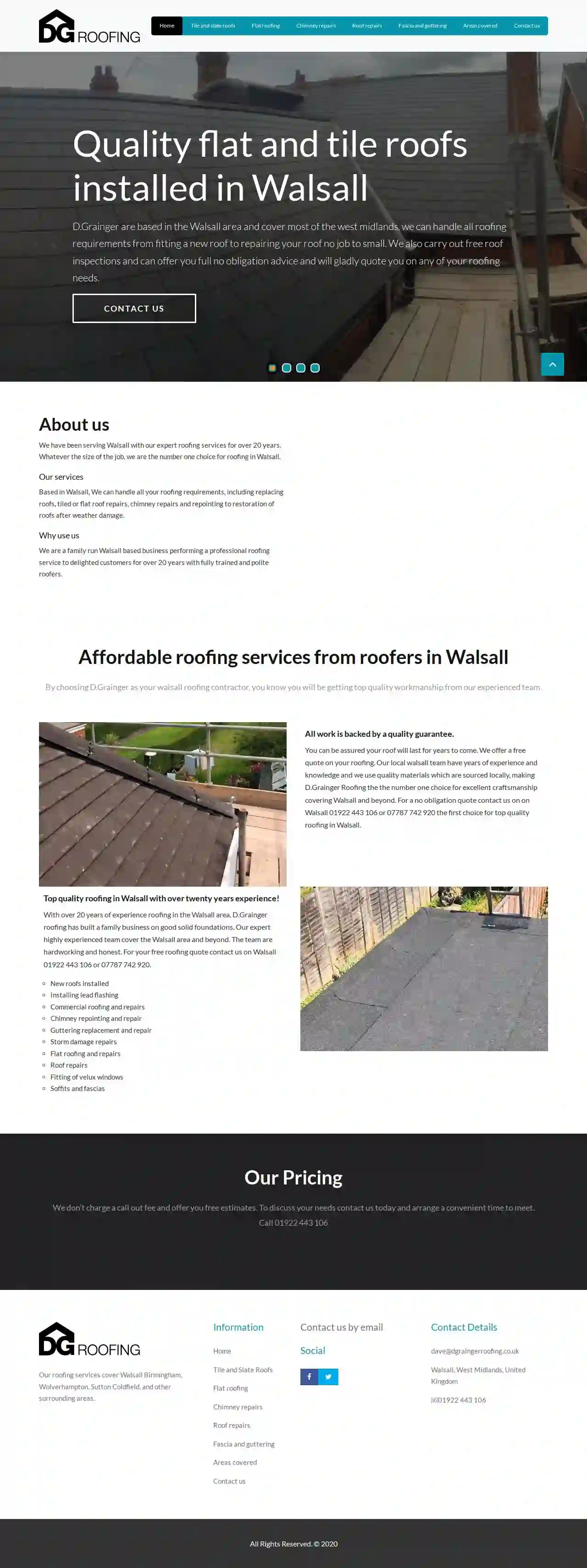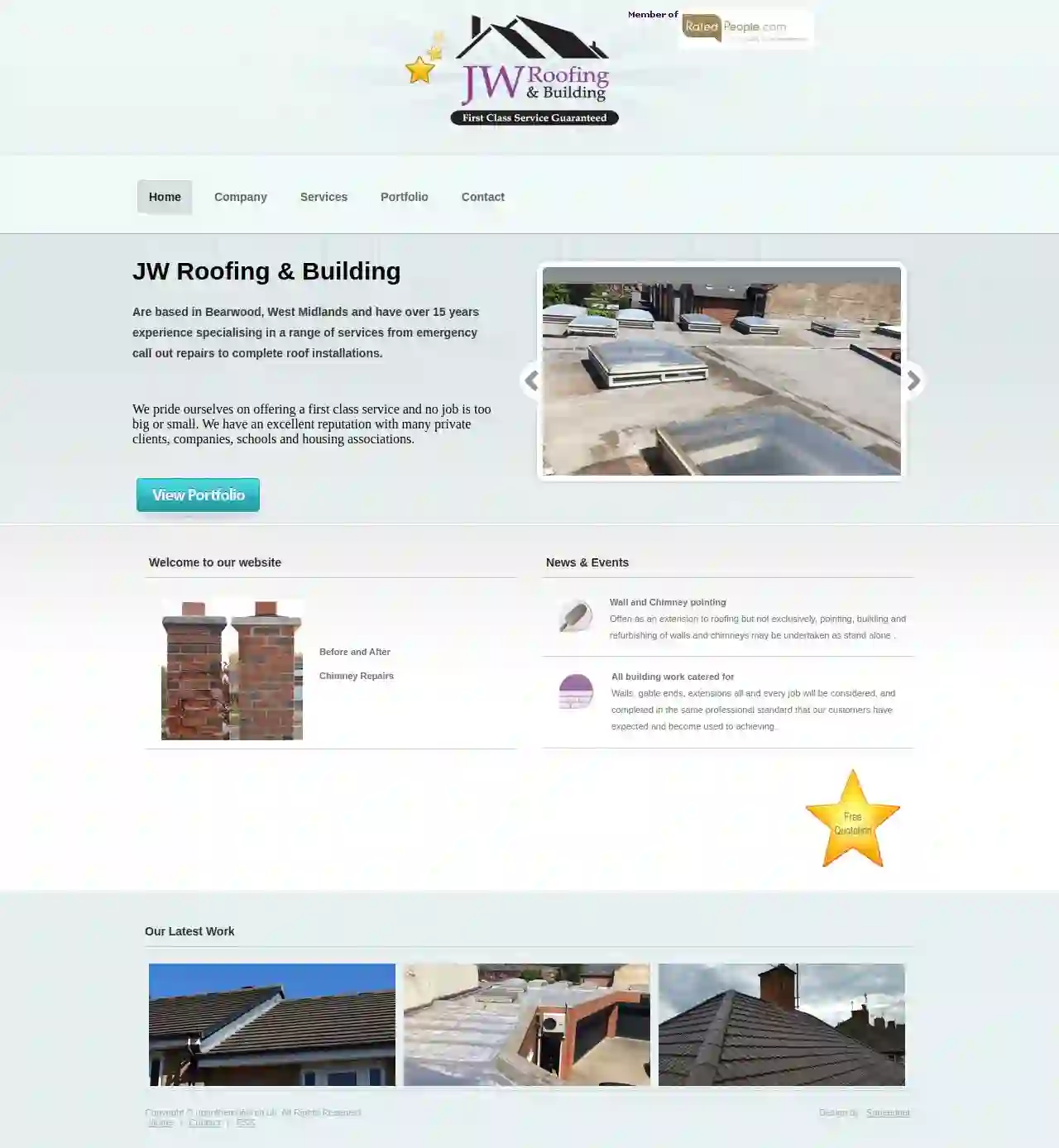Rubber Roof Installers West Bromwich
Find the best EPDM Roof Installer in West Bromwich
Receive 3 FREE EPDM Roof Installer quotes for your project today! Compare profiles, reviews, accreditations, portfolio, etc... and choose the best deal.

Weaver Industrial Roofing
51 reviewsWoodsetton, Dudley, 2 Masefield Avenue, GBWeaver Industrial Roofing offers industrial and domestic roofing services including felt roofing repairs, new felt roofs, tile roof repairs, hip tiles, UPVC facia, guttering, Chimneys repaired, replacement Filon sheets, gutter cleaning, re-roofing, cut out and repoint morter, lead flashings fitted, re-bed ridge tiles, Sky lights fitted, Velux lights installed, Cladding replaced, Single ply systems, liquid plastic system, pointing up, warm roofs insulation and Vapour layer. We cover many areas across the West Midlands including, Sedgley, Wolverhampton, Dudley, Wombourne, Wordsley, Coseley, Upper and lower Gornall, The Straights, Penn, Goldthorne, Gornal Wood, Tipton, Roseville, Kinver, Wall Heath, Pensnett, Cradley Heath, Netherton. We pride ourselves on offering you the very best solutions for your roof repairs and new installations. We keep up to date with the latest systems while at the same time can offer authentic solutions for older buildings. One example of this are the old coal tar roofs we have worked on at The Black Country Living Museum. So whether you have a period building or a modern one, large or small, residential or industrial, we can offer the skills and experience to provide you with exactly what you need. We offer free, no obligation quotations, all work is completed professionally, and you can have peace of mind knowing we have full public liability insurance. On top of that all our work is guaranteed.
- Services
- Why Us?
- Our Team
- Gallery
Get Quote
G&M Roofing Services
4.713 reviews36 Hill Street, Burntwood, WS7 3XU, GBG&M Roofing Services is a team of fully-certified professionals dedicated to providing high-quality roofing services to clients across Staffordshire. With years of experience, we tackle projects ranging from small repairs to large-scale installations. Our commitment to customer satisfaction is reflected in our honest, hard-working ethic and our use of traditional methods and top-quality materials. We strive to offer competitive prices without compromising on the quality of our workmanship, ensuring you receive superior roofing solutions without breaking the bank.
- Services
- Why Us?
- Our Team
- Testimonials
- Gallery
Get Quote
J Harris Roofing
Cannock, 47 Rowan Close, WS12 4GD, GBJ Harris Roofing is a renowned family-run business providing professional and reliable roofing services in Cannock and surrounding areas. With a reputation for supplying first-class roofing services at an affordable price, we pledge to treat your property with respect and care. Our team of experienced and highly skilled roofers perform all manner of commercial and domestic roofing works, using only the best materials and techniques. We specialize in new roofs, flat roofs, garage roofs, emergency roof repairs, skylights, velux windows, drone surveys, chimneys, lead work, waterproofing, liquid roofing system, guttering, roof insulation, rubber roofing, green roofs, and cladding, fascias, and soffits. Our commitment to excellent customer service, attention to detail, and pride in our work ensures a pleasant and satisfying experience for every customer.
- Services
- Why Us?
- Accreditations
- Our Team
- Gallery
Get Quote
Seal max roofing
Acocks Green, B13, GBWest Midlands Roofing Network is a network of roofing professionals serving the Acocks Green area. They offer a wide range of roofing services for both residential and commercial properties, including roof repairs, flat roofing, guttering, fascias & soffits, and more. The company emphasizes the importance of a well-built roof and highlights the potential damage that even small leaks can cause. They encourage homeowners to contact them for a free quote if they need any roofing services.
- Services
- Why Us?
- Gallery
Get Quote
National Plastics, Wolverhampton
4.79 reviewsGBNational Plastics is a leading supplier of high-quality plastic building products to both trade and DIY customers. With a wide range of products including bathroom wall panels, kitchen wall panels, fascia and soffit boards, guttering, trims, and more, we offer competitive prices and nationwide coverage with branches conveniently located across the UK. Our team of experts is dedicated to providing exceptional customer service and helping you find the perfect solutions for your building projects.
- Services
- Why Us?
- Accreditations
- Our Team
- Testimonials
- Gallery
Get Quote
Bromsgrove Roofing
4.25 reviewsBromsgrove, B60, GBWest Midlands Roofing Network is a network of roofing professionals serving Bromsgrove and surrounding areas. We offer a wide range of roofing services for both domestic and commercial properties, including roof repairs, flat roofing, guttering, fascias & soffits, and more. Our members are experienced and qualified roofers who are committed to providing high-quality workmanship and customer service. We understand that your roof is a vital part of your home or business, and we take pride in providing reliable and durable solutions to protect your investment. Whether you need a small repair or a complete roof replacement, our team can help. Contact us today for a free quote and let us take care of all your roofing needs.
- Services
- Why Us?
- Gallery
Get Quote
James Mathew Roofing Ltd
12 reviewsBillesley, GBWest Midlands Roofing Network is a network of roofing professionals serving Billesley and surrounding areas. We offer a wide range of roofing services for both residential and commercial customers, including roof repairs, flat roofing, guttering, fascias & soffits, and more. Our members are experienced and qualified roofers who are committed to providing high-quality workmanship at competitive prices. We understand that your roof is a vital part of your home or business, and we take pride in providing reliable and durable roofing solutions. Whether you need a small repair or a complete roof replacement, our team can help. Contact us today for a free quote.
- Services
- Why Us?
- Gallery
Get Quote
D Grainger Roofing
527 reviewsWalsall, GBD.Grainger are based in the Walsall area and cover most of the west midlands, we can handle all roofing requirements from fitting a new roof to repairing your roof no job to small. We also carry out free roof inspections and can offer you full no obligation advice and will gladly quote you on any of your roofing needs. We have been serving Walsall with our expert roofing services for over 20 years. Whatever the size of the job, we are the number one choice for roofing in Walsall.Our services include replacing roofs, tiled or flat roof repairs, chimney repairs and repointing to restoration of roofs after weather damage. We are a family run Walsall based business performing a professional roofing service to delighted customers for over 20 years with fully trained and polite roofers.
- Services
- Why Us?
- Gallery
Get Quote
JW Roofing & Building
1.77 reviews80 Abbey Road, Birmingham, B67 5LH, GBJW Roofing & Building is a company based in Bearwood, West Midlands, with over 15 years of experience in a range of roofing services. From emergency call-out repairs to complete roof installations, they pride themselves on offering a first-class service for both domestic and commercial clients. They have a strong reputation with private clients, companies, schools, and housing associations. The company is committed to providing a professional, efficient, and quality service, with a focus on customer satisfaction. They are fully insured and offer a 7-day-a-week call-out service. JW Roofing & Building is an approved contractor for Sandwell Council and a member of Rated People, boasting an expert status due to numerous five-star ratings.
- Services
- Why Us?
- Accreditations
- Our Team
- Testimonials
- Gallery
Get Quote
1st Choice Roofing
59 reviews28 Nayland Croft, Birmingham, B28 0QH, GB1st Choice Roofing & Building Ltd is a well-established company based in Birmingham, West Midlands. We offer both private and commercial roofing and building services to suit all requirements. We provide superior roofing services, including slate roofing, tile roofing, flat roofing, guttering, chimneys, and lead work. Our team is fully trained and qualified, and we offer a 7-day, 24-hour storm-damaged roof repairs and emergency call-out service. We have over 20 years of experience and have completed thousands of successful projects. Our mission is to provide exceptional service and quality workmanship to our customers.
- Services
- Why Us?
- Testimonials
- Gallery
Get Quote
Over 12,314+ Roofers in our network
Our roofing pros operate in West Bromwich and surrounding areas!
Roofyng.co.uk has curated and vetted Top Roofing Contractors arround West Bromwich. Find the most trustworthy contractor today.
Rubber Roof Installation FAQs
- The size and complexity of the roof
- The thickness of the EPDM membrane (45 mil, 60 mil, 90 mil)
- The installation method (fully adhered, mechanically attached, ballasted)
- Whether the existing roof needs to be removed
- The cost of insulation and other materials
- Labor costs in your region
- Age: If your flat roof is nearing the end of its expected lifespan (15-30 years for most flat roofing systems), a replacement is usually a better investment than continual repairs.
- Extensive Damage: If the roof has experienced significant damage, such as widespread leaks, ponding water, or structural issues, replacement is often more cost-effective than trying to repair multiple problems.
- Recurring Leaks: If you've had multiple leaks that have been repaired but keep reappearing, it could indicate a systemic problem with the roofing system that warrants a replacement.
- Deteriorated Membrane: If the waterproofing membrane is showing signs of widespread deterioration, cracking, blistering, or alligatoring (a pattern of cracks resembling alligator skin), it's likely time for a replacement.
- Energy Efficiency: If your flat roof is poorly insulated, resulting in high energy bills, a replacement with a more energy-efficient roofing system could be a wise investment.
- Manufacturer's Warranty: Covers defects in the EPDM membrane itself, typically ranging from 10 to 30 years or more, depending on the manufacturer and the membrane's thickness.
- Contractor's Warranty: Covers the installation workmanship, usually for a shorter period, such as 1 to 5 years.
How much does a rubber roof cost in the UK?
How do I know if my flat roof needs replacing?
Can you repair a rubber roof?
What is the warranty on an EPDM rubber roof?
How much does a rubber roof cost in the UK?
- The size and complexity of the roof
- The thickness of the EPDM membrane (45 mil, 60 mil, 90 mil)
- The installation method (fully adhered, mechanically attached, ballasted)
- Whether the existing roof needs to be removed
- The cost of insulation and other materials
- Labor costs in your region
How do I know if my flat roof needs replacing?
- Age: If your flat roof is nearing the end of its expected lifespan (15-30 years for most flat roofing systems), a replacement is usually a better investment than continual repairs.
- Extensive Damage: If the roof has experienced significant damage, such as widespread leaks, ponding water, or structural issues, replacement is often more cost-effective than trying to repair multiple problems.
- Recurring Leaks: If you've had multiple leaks that have been repaired but keep reappearing, it could indicate a systemic problem with the roofing system that warrants a replacement.
- Deteriorated Membrane: If the waterproofing membrane is showing signs of widespread deterioration, cracking, blistering, or alligatoring (a pattern of cracks resembling alligator skin), it's likely time for a replacement.
- Energy Efficiency: If your flat roof is poorly insulated, resulting in high energy bills, a replacement with a more energy-efficient roofing system could be a wise investment.
Can you repair a rubber roof?
What is the warranty on an EPDM rubber roof?
- Manufacturer's Warranty: Covers defects in the EPDM membrane itself, typically ranging from 10 to 30 years or more, depending on the manufacturer and the membrane's thickness.
- Contractor's Warranty: Covers the installation workmanship, usually for a shorter period, such as 1 to 5 years.